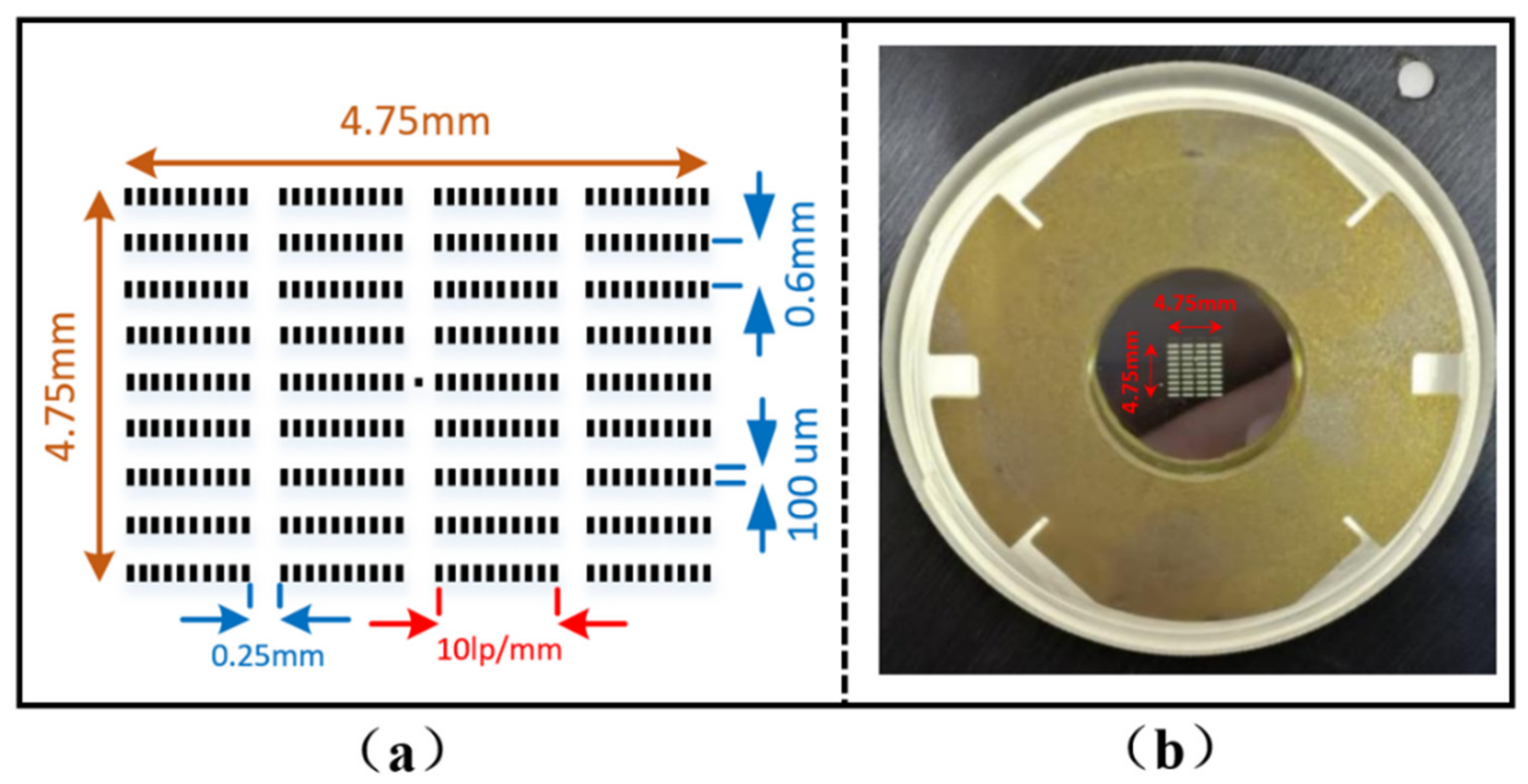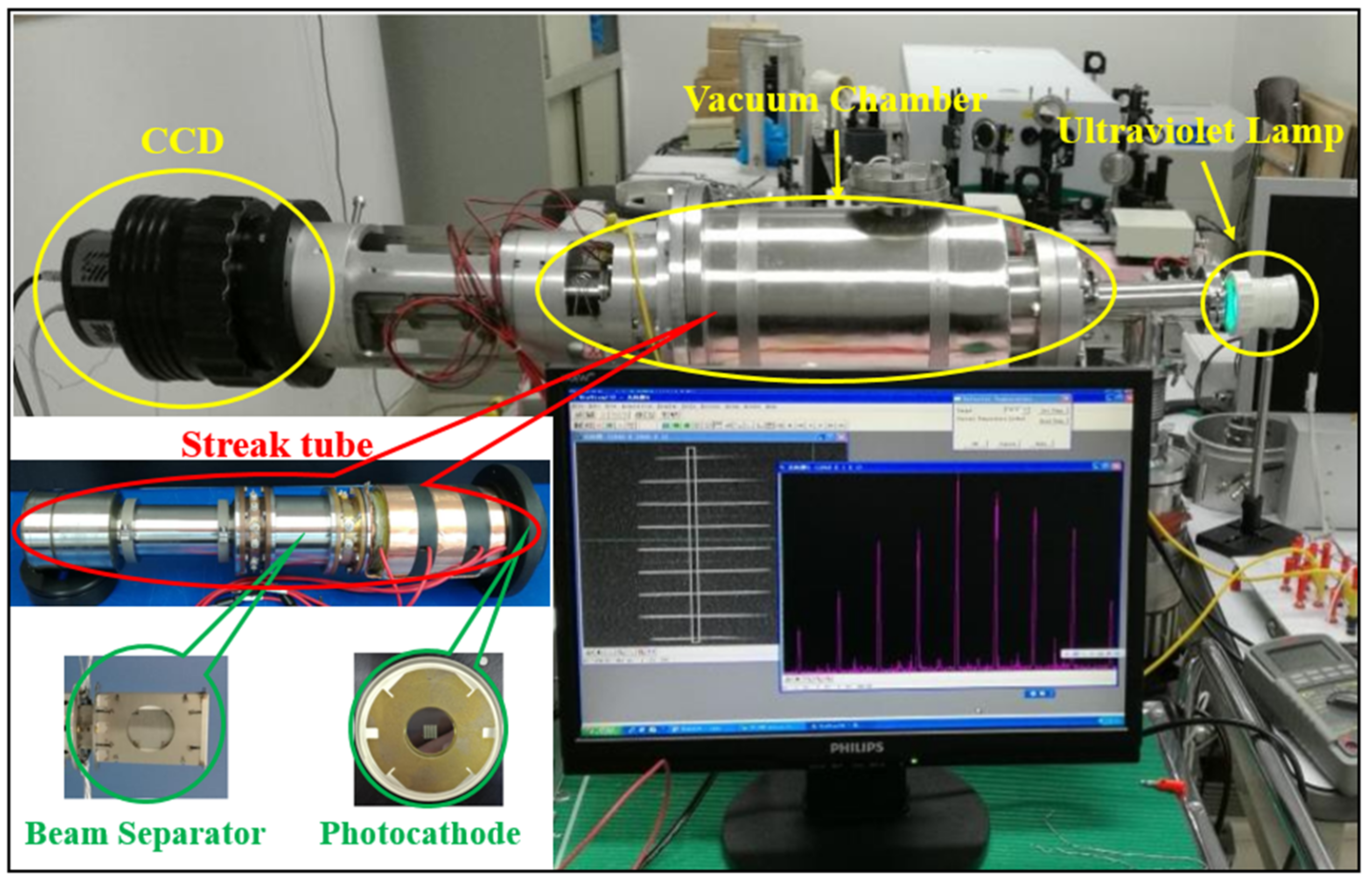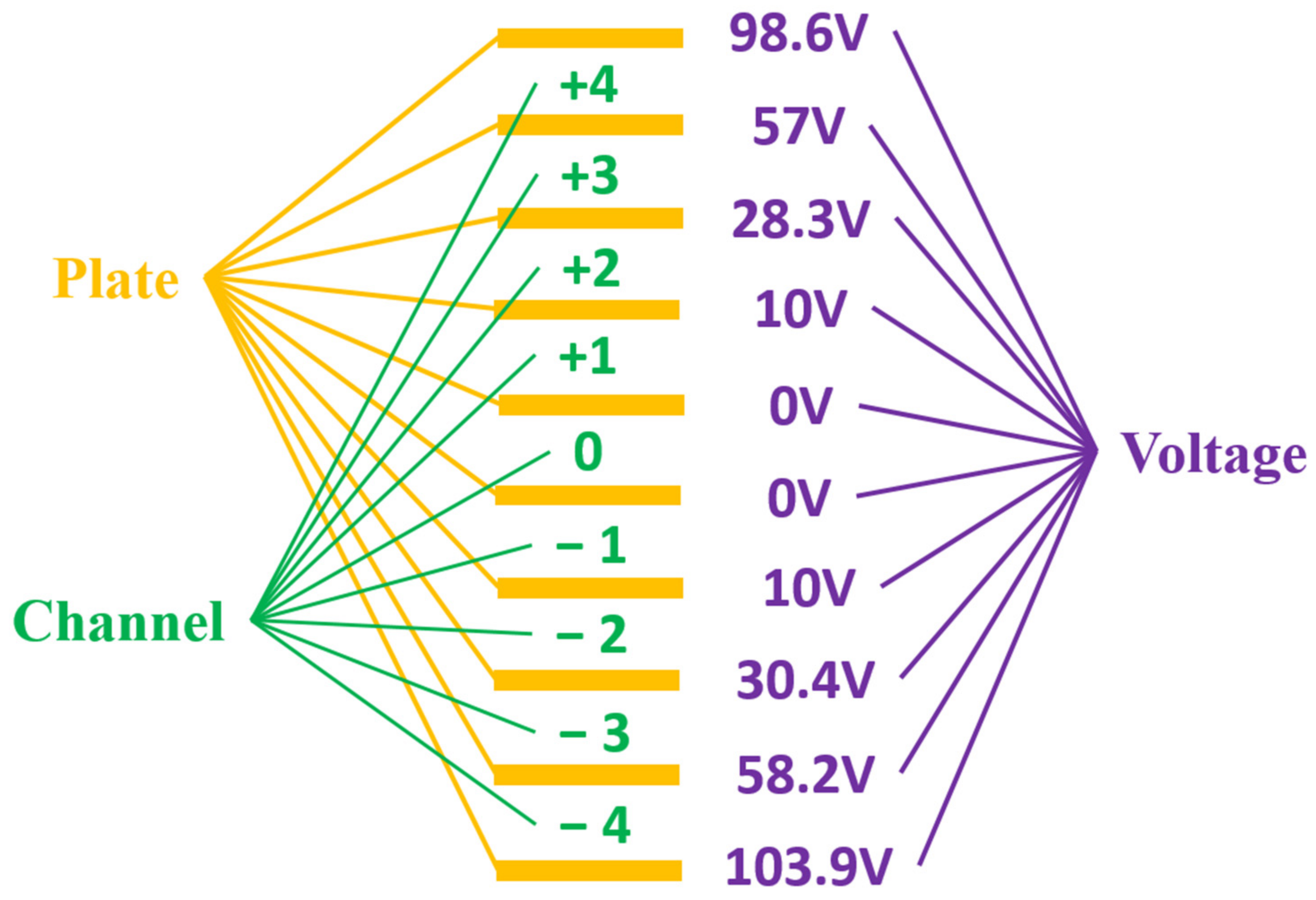Secondary Amplifier Sampling Component Design of an X-ray Framing Detector Based on a Streak Tube
Abstract
1. Introduction
2. Design Strategy
3. Development and Experimental Testing of Device
4. Experimental Test and Analysis
- (1)
- From Formula (2), the corresponding voltage of the central channel array should be .
- (2)
- The voltage of each channel array above the central channel array should be , while the voltage of each channel array below should be .
- (3)
- The final amplification effect should be the same scale on both sides; therefore, .
- (4)
- Similarly (from Figure 4a), the off-axis height of each row of stripes on both sides of the centre should be the integral multiple number of the base , that is, h_ I = I ∗ h_ 0 (i = −4, −3, …, 0, …, +3, +4) to achieve the same scale amplification on both sides, and according to Equation (2) there should be , where is calculated by substituting into Equation (2).
5. Conclusions
Author Contributions
Funding
Institutional Review Board Statement
Informed Consent Statement
Data Availability Statement
Conflicts of Interest
References
- Betti, R.; Hurricane, O.A. Inertial-confinement fusion with lasers. Nat. Phys. 2016, 12, 435–449. [Google Scholar] [CrossRef]
- Callahan, D.A.; Hurricane, O.A.; Hinkel, D.E.; Döppner, T.; Ma, T.; Park, H.S.; Barrios Garcia, M.A.; Berzak Hopkins, L.F.; Casey, D.T.; Cerjan, C.J.; et al. Higher velocity, high-foot implosions on the National Ignition Facility laser. Phys. Plasmas 2015, 22, 056314. [Google Scholar] [CrossRef]
- Hurricane, O.A.; Callahan, D.A.; Casey, D.T.; Celliers, P.M.; Cerjan, C.; Dewald, E.L.; Dittrich, T.R.; Döppner, T.; Hinkel, D.E.; Hopkins, L.F.B.; et al. Fuel gain exceeding unity in an inertially confined fusion implosion. Nature 2014, 506, 343–348. [Google Scholar] [CrossRef] [PubMed]
- Danly, C.; Christensen, K.; Fatherley, V.; Fittinghoff, D.N.; Grim, G.P.; Hibbard, R.; Izumi, N.; Jedlovec, D.; Merrill, F.E.; Schmidt, D.W.; et al. Combined neutron and x-ray imaging at the National Ignition Facility. Rev. Sci. Instrum. 2016, 87, 11D703. [Google Scholar] [CrossRef] [PubMed]
- Bachmann, B.; Hilsabeck, T.; Field, J.; Masters, N.; Reed, C.; Pardini, T.; Rygg, J.R.; Alexander, N.; Benedetti, L.R.; Döppner, T.; et al. Resolving hot spot microstructure using x-ray penumbral imaging. Rev. Sci. Instrum. 2016, 87, 11E201. [Google Scholar] [CrossRef] [PubMed]
- Pickworth, L.A.; Ayers, J.; Bell, P.; Brejnholt, N.F.; Buscho, J.G.; Bradley, D.; Decker, T.; Hau-Riege, S.; Kilkenny, J.; McCarville, T.; et al. The National Ignition Facility modular Kirkpatrick-Baez microscope. Rev. Sci. Instrum. 2016, 87, 073501. [Google Scholar] [CrossRef] [PubMed]
- Hu, S.X.; Michel, D.T.; Davis, A.K.; Betti, R.; Radha, P.B.; Campbell, E.M.; Froula, D.H.; Stoeckl, C. Understanding the effects of laser imprint on plastic-target implosions on OMEGA. Phys. Plasmas 2016, 23, 102701. [Google Scholar]
- Igumenshchev, I.V.; Goncharov, V.N.; Marshall, F.J.; Knauer, J.P.; Campbell, E.M.; Forrest, C.J.; Froula, D.H.; Glebov, V.Y.; McCrory, R.L.; Regan, S.P.; et al. Three-dimensional modeling of direct-drive cryogenic implosions on OMEGA. Phys. Plasmas 2016, 23, 052702. [Google Scholar] [CrossRef]
- Spears, B.K.; Munro, D.H.; Sepke, S.; Caggiano, J.; Clark, D.; Hatarik, R.; Kritcher, A.; Sayre, D.; Yeamans, C.; Knauer, J.; et al. Three-dimensional simulations of National Ignition Facility implosions: Insight into experimental observables. Phys. Plasmas 2015, 22, 056317. [Google Scholar] [CrossRef]
- Rosch, R.; Trosseille, C.; Caillaud, T.; Allouche, V.; Bourgade, J.L.; Briat, M.; Brunel, P.; Burillo, M.; Casner, A.; Depierreux, S.; et al. First set of gated x-ray imaging diagnostics for the Laser Megajoule facility. Rev. Sci. Instrum. 2016, 87, 033706. [Google Scholar] [CrossRef]
- Bose, A.; Woo, K.M.; Betti, R.; Campbell, E.M.; Mangino, D.; Christopherson, A.R.; McCrory, R.L.; Nora, R.; Regan, S.P.; Goncharov, V.N.; et al. Core conditions for alpha heating attained in direct-drive inertial confinement fusion. Phys. Rev. E 2016, 94, 011201. [Google Scholar] [CrossRef] [PubMed]
- Hilsabeck, T.J.; Frenje, J.; Hares, J.; Wink, C.W. A stretch/compress scheme for a high temporal resolution detector for the magnetic recoil spectrometer time (MRSt). Rev. Sci. Instrum. 2016, 87, 11D807. [Google Scholar] [CrossRef]
- Li, L.; Zhang, W.; Jing, L.; Du, H.; Zhang, L.; Zheng, J.; Li, H.; Lin, Z.; Zhan, X.; Yu, R.; et al. Optimization of tungsten-doped high density carbon target in inertial confinement fusion. Nucl. Fusion 2021, 61, 126023. [Google Scholar] [CrossRef]
- Tikhonchuk, V.; Gu, Y.J.; Klimo, O.; Limpouch, J.; Weber, S. Studies of laser-plasma interaction physics with low-density targets for direct-drive inertial confinement fusion on the Shen guang III prototype. Matter Radiat. Extrem. 2021, 6, 54–66. [Google Scholar] [CrossRef]
- Hurricane, O.A.; Callahan, D.A.; Springer, P.T.; Edwards, M.J.; Patel, P.; Baker, K.; Casey, D.T.; Divol, L.; Döppner, T.; Hinkel, D.E.; et al. Beyond alpha-heating: Driving inertially confined fusion implosions toward a burning-plasma state on the National Ignition Facility. Plasma Phys. Control. Fusion 2019, 61, 014033. [Google Scholar] [CrossRef]
- Kilkenny, J.D. High speed proximity focused X-ray cameras. Laser Part. Beams 1991, 9, 49–69. [Google Scholar] [CrossRef]
- Bell, P.M.; Kilkenny, J.D.; Hanks, R.L.; Landen, O.L. Measurements with a 35 psec gate time microchannel plate camera. In Proceedings of the 34th Annual International Technical Symposium on Optical and Optoelectronic Applied Science and Engineering, San Diego, CA, USA, 8–13 July 1990; Volume 1346, pp. 456–464. [Google Scholar]
- Engelhorn, K.; Hilsabeck, T.J.; Kilkenny, J.; Morris, D.; Chung, T.M.; Dymoke-Bradshaw, A.; Hares, J.D.; Bell, P.; Bradley, D.; Carpenter, A.C.; et al. Sub-nanosecond single line-of-sight (SLOS) X-ray imagers. Rev. Sci. Instrum. 2018, 89, 10G123. [Google Scholar] [CrossRef]
- Fu, W.; Cai, H.; Wang, D.; Lei, Y.; Liu, J. Time resolved x-ray image of laser plasma interactions using a dilation framing camera. Optik 2019, 186, 374–378. [Google Scholar] [CrossRef]
- Cai, H.; Fu, W.; Wang, D.; Lei, Y.; Gu, L.; Liu, J. Large-format pulse-dilation framing tube with 5 1p/mm spatial resolution. Optik 2019, 185, 441–446. [Google Scholar] [CrossRef]
- Liu, J.; Fu, W.; Deng, P.; Wang, D.; Lei, Y.; Huang, J.; Wang, Y.; Cai, H. Simulation of a pulse-dilation framing tube with sensitive diameter of 60 mm using large aperture short magnetic lens. Optik 2020, 203, 163974. [Google Scholar] [CrossRef]
- Cai, H.; Fu, W.; Wang, D.; Lei, Y.; Liu, J. Three-strip microchannel plate gated x-ray framing camera. Sens. Actuators A. Phys. 2019, 285, 355–361. [Google Scholar] [CrossRef]
- Dong, J.; Deng, K.; Wang, Q.; Ren, K.; Cao, Z.; Jiang, S. Experimental study on the asymmetry of implosion hot spot based on multi-channel Kirkpatrick-Baez microscope. Nucl. Fusion Plasma Phys. 2018, 38, 125–129. [Google Scholar]
- Shiraga, H. Review of Concepts and Applications of Image Sampling on High Speed Streak Cameras. In Selected Papers from the 31st International Congress on High-Speed Imaging and Photonics; SPIE: Bellingham, WA, USA, 2017; Volume 103280R, pp. 146–152. [Google Scholar]
- Ji, L.; Le Qu, J.; Lan, Z.J.; Yang, Q.L.; Zhang, H.; Niu, H. Sampling-image streak framing technique and its special streak image tube. Nucl. Instrum. Methods Phys. Res. A 2002, 489, 241–246. [Google Scholar] [CrossRef]
- Available online: http://www.newwaymask.com/ (accessed on 25 February 2023).
- Zhang, J.; Liu, A.; Guo, B.; Yang, Q.; Zong, F. Influence of geomagnetic field on the imaging performance of a streak tube. Nucl. Inst. Methods Phys. Res. A 2020, 950, 162808. [Google Scholar]
- Zhou, L. Electron Optics with Wide Beam Focusing; Beijing Institute of Technology Press: Beijing, China, 1993; p. 133. [Google Scholar]








| Length of Focus Region | Tube Length | Total Voltage | Lateral Magnification |
|---|---|---|---|
| 135 mm | 460 mm | 10 kV | 2.84 |
| Pole | Photocathode | Grid | Focus Pole | Anode Pole |
|---|---|---|---|---|
| Voltage(kV) | −10 | −5.967 | −8.236 | 0 |
| Channel | −4 | −3 | −2 | −1 | 0 | 1 | 2 | 3 | 4 |
|---|---|---|---|---|---|---|---|---|---|
| Original spatial resolution (lp/mm) | 10 | ||||||||
| Modulation degree (%) | 0.514 | 0.622 | 0.611 | 0.693 | 0.649 | 0.595 | 0.545 | 0.511 | 0.475 |
| Limit spatial resolution (lp/mm) | 21.2 | 25.1 | 25 | 28.6 | 26.3 | 24 | 22.2 | 21.1 | 20.1 |
| Channel | −4 | −3 | −2 | −1 | 0 | +1 | +2 | +3 | +4 |
|---|---|---|---|---|---|---|---|---|---|
| (V) | −45.7 | −27.8 | −20.4 | −10 | 0 | 10 | 18.3 | 28.3 | 41.6 |
| (mm) | −5.941 | −3.614 | −2.652 | −1.3 | 0 | 1.3 | 2.379 | 3.679 | 5.408 |
| 5.30 | 4.84 | 5.04 | 5 | — | 5 | 4.81 | 4.87 | 5.08 | |
| 1.867 | 1.704 | 1.775 | 1.761 | — | 1.761 | 1.694 | 1.715 | 1.789 |
| Parameters | Streak Tube with Secondary Amplification Device Powered on | Streak Tube without Secondary Amplification Device Powered on |
|---|---|---|
| Tube length (mm) | 460 | 460 |
| Diameter of tube (mm) | 60 | 60 |
| Static spatial resolution (lp/mm) | 10 | 10 |
| Transverse magnification | 5.03 | 2.84 |
Disclaimer/Publisher’s Note: The statements, opinions and data contained in all publications are solely those of the individual author(s) and contributor(s) and not of MDPI and/or the editor(s). MDPI and/or the editor(s) disclaim responsibility for any injury to people or property resulting from any ideas, methods, instructions or products referred to in the content. |
© 2023 by the authors. Licensee MDPI, Basel, Switzerland. This article is an open access article distributed under the terms and conditions of the Creative Commons Attribution (CC BY) license (https://creativecommons.org/licenses/by/4.0/).
Share and Cite
Zhang, J.-j.; Xu, Y.-w.; Zong, F.-k.; Niu, L.-h.; Lei, B.-g.; Yang, Q.-l.; Cai, H.-z. Secondary Amplifier Sampling Component Design of an X-ray Framing Detector Based on a Streak Tube. Sensors 2023, 23, 2700. https://doi.org/10.3390/s23052700
Zhang J-j, Xu Y-w, Zong F-k, Niu L-h, Lei B-g, Yang Q-l, Cai H-z. Secondary Amplifier Sampling Component Design of an X-ray Framing Detector Based on a Streak Tube. Sensors. 2023; 23(5):2700. https://doi.org/10.3390/s23052700
Chicago/Turabian StyleZhang, Jing-jin, Yu-wei Xu, Fang-ke Zong, Li-hong Niu, Bao-guo Lei, Qin-lao Yang, and Hou-zhi Cai. 2023. "Secondary Amplifier Sampling Component Design of an X-ray Framing Detector Based on a Streak Tube" Sensors 23, no. 5: 2700. https://doi.org/10.3390/s23052700
APA StyleZhang, J.-j., Xu, Y.-w., Zong, F.-k., Niu, L.-h., Lei, B.-g., Yang, Q.-l., & Cai, H.-z. (2023). Secondary Amplifier Sampling Component Design of an X-ray Framing Detector Based on a Streak Tube. Sensors, 23(5), 2700. https://doi.org/10.3390/s23052700






